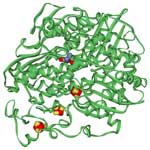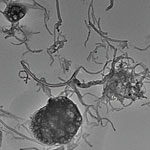Showing Spotlights 113 - 120 of 151 in category All (newest first):
 The hydrogen that will power tomorrow's cars is not a naturally occurring resource that can be tapped by drilling a hole in the ground. Hydrogen has to be produced, and that can be done using a variety of resources. The cleanest by far of course would be renewable energy electrolysis: using electricity to split water into hydrogen and oxygen; this electricity could be generated using renewable energy technologies such as wind, solar, geo- and hydrothermal power. As it stands, most of today's hydrogen production is 'dirty' - it is produced from methane in natural gas using high-temperature steam in what is called steam methane reforming. Many research groups around the world are working hard on developing cheap, clean and efficient technologies to produce hydrogen from water, particularly using sunlight (artificial photosynthesis). This would be the ultimate clean, renewable and abundant energy source. However, to become commercially viable, fuel cells have to overcome the barrier of high catalyst cost caused by the exclusive use of expensive platinum and platinum-based catalysts in the fuel-cell electrodes - the reason is that platinum is the most efficient electrocatalyst for accelerating chemical reactions in fuel cells. Scientists have found that platinum catalysts can be replaced with bacteria-produced hydrogenase enzymes that have nickel and iron in their active sites.
The hydrogen that will power tomorrow's cars is not a naturally occurring resource that can be tapped by drilling a hole in the ground. Hydrogen has to be produced, and that can be done using a variety of resources. The cleanest by far of course would be renewable energy electrolysis: using electricity to split water into hydrogen and oxygen; this electricity could be generated using renewable energy technologies such as wind, solar, geo- and hydrothermal power. As it stands, most of today's hydrogen production is 'dirty' - it is produced from methane in natural gas using high-temperature steam in what is called steam methane reforming. Many research groups around the world are working hard on developing cheap, clean and efficient technologies to produce hydrogen from water, particularly using sunlight (artificial photosynthesis). This would be the ultimate clean, renewable and abundant energy source. However, to become commercially viable, fuel cells have to overcome the barrier of high catalyst cost caused by the exclusive use of expensive platinum and platinum-based catalysts in the fuel-cell electrodes - the reason is that platinum is the most efficient electrocatalyst for accelerating chemical reactions in fuel cells. Scientists have found that platinum catalysts can be replaced with bacteria-produced hydrogenase enzymes that have nickel and iron in their active sites.
Dec 10th, 2008
 As we have show before, nanotechnology applications could provide decisive technological breakthroughs in the energy sector and have a considerable impact on creating the sustainable energy supply that is required to make the transition from fossil fuels. Although we love to write about all the clean and green applications that will be nanotechnology enabled, the harsh reality is that dirty energy is still fuelling our way of life. No matter if you are a member of the "drill, baby, drill" crowd or if you are actively involved in saving energy and think that the development of renewable energies can't come fast enough, we have to live with the fact that the world's energy production will continue to depend on oil, gas and coal for quite a few more years. But even here, nanotechnology applications might offer some improvements. A new report shows that nanotechnology, in the form of carbon nanotube rubber composites, could help to significantly enhance oil production efficiency by allowing to probe and drill deeper wells.
As we have show before, nanotechnology applications could provide decisive technological breakthroughs in the energy sector and have a considerable impact on creating the sustainable energy supply that is required to make the transition from fossil fuels. Although we love to write about all the clean and green applications that will be nanotechnology enabled, the harsh reality is that dirty energy is still fuelling our way of life. No matter if you are a member of the "drill, baby, drill" crowd or if you are actively involved in saving energy and think that the development of renewable energies can't come fast enough, we have to live with the fact that the world's energy production will continue to depend on oil, gas and coal for quite a few more years. But even here, nanotechnology applications might offer some improvements. A new report shows that nanotechnology, in the form of carbon nanotube rubber composites, could help to significantly enhance oil production efficiency by allowing to probe and drill deeper wells.
Nov 11th, 2008
 The toxicity issues surrounding carbon nanotubes (CNTs) are highly relevant for two reasons: Firstly, as more and more products containing CNTs come to market, there is a chance that free CNTs get released during their life cycles, most likely during production or disposal, and find their way through the environment into the body. Secondly, and much more pertinent with regard to potential health risks, is the use of CNTs in biological and medical settings. CNTs interesting structural, chemical, electrical, and optical properties are explored by numerous nanomedicine research groups around the world with the goal of drastically improving performance and efficacy of biological detection, imaging, and therapy applications. In many of these envisaged applications, CNTs would be deliberately injected or implanted in the body. While it has been shown that carbon nanotubes can indeed act as a means for drug delivery, negative effects such as unusual and robust inflammatory response, oxidative stress and formation of free radicals, and the accumulation of peroxidative products have also been found as a result of carbon nanotubes and their accumulated aggregates. As a possible solution, scientists have provided compelling evidence of the biodegradation of carbon nanotubes by horseradish peroxidase and hydrogen peroxide over the period of several weeks. This marks a promising possibility for nanotubes to be degraded by horseradish peroxidase in environmentally relevant settings.
The toxicity issues surrounding carbon nanotubes (CNTs) are highly relevant for two reasons: Firstly, as more and more products containing CNTs come to market, there is a chance that free CNTs get released during their life cycles, most likely during production or disposal, and find their way through the environment into the body. Secondly, and much more pertinent with regard to potential health risks, is the use of CNTs in biological and medical settings. CNTs interesting structural, chemical, electrical, and optical properties are explored by numerous nanomedicine research groups around the world with the goal of drastically improving performance and efficacy of biological detection, imaging, and therapy applications. In many of these envisaged applications, CNTs would be deliberately injected or implanted in the body. While it has been shown that carbon nanotubes can indeed act as a means for drug delivery, negative effects such as unusual and robust inflammatory response, oxidative stress and formation of free radicals, and the accumulation of peroxidative products have also been found as a result of carbon nanotubes and their accumulated aggregates. As a possible solution, scientists have provided compelling evidence of the biodegradation of carbon nanotubes by horseradish peroxidase and hydrogen peroxide over the period of several weeks. This marks a promising possibility for nanotubes to be degraded by horseradish peroxidase in environmentally relevant settings.
Nov 10th, 2008
 There is a general perception that nanotechnologies will have a significant impact on developing 'green' and 'clean' technologies with considerable environmental benefits - be it in areas ranging from water treatment to energy breakthroughs and hydrogen applications. As a matter of fact, renewable energy applications probably are the areas where nanotechnology will make its first large-scale commercial breakthroughs. Conflicting with this positive message is the growing body of research that raises questions about the potentially negative effects of engineered nanoparticles on human health and the environment. However, there is one area of nanotechnology that so far hasn't received the necessary attention: the actual processes of manufacturing nanomaterials and the environmental footprint they create, in absolute terms and in comparison with existing industrial manufacturing processes. Analogous to other industrial manufacturing processes, nanoproducts must proceed through various manufacturing stages to produce a material or device with nanoscale dimensions.
There is a general perception that nanotechnologies will have a significant impact on developing 'green' and 'clean' technologies with considerable environmental benefits - be it in areas ranging from water treatment to energy breakthroughs and hydrogen applications. As a matter of fact, renewable energy applications probably are the areas where nanotechnology will make its first large-scale commercial breakthroughs. Conflicting with this positive message is the growing body of research that raises questions about the potentially negative effects of engineered nanoparticles on human health and the environment. However, there is one area of nanotechnology that so far hasn't received the necessary attention: the actual processes of manufacturing nanomaterials and the environmental footprint they create, in absolute terms and in comparison with existing industrial manufacturing processes. Analogous to other industrial manufacturing processes, nanoproducts must proceed through various manufacturing stages to produce a material or device with nanoscale dimensions.
Oct 22nd, 2008
 Safe, efficient and compact hydrogen storage is a major challenge in order to realize hydrogen powered transport. According to the U.S. Department of Energy Freedom CAR program roadmap, the on-board hydrogen storage system should provide 6 weight % of hydrogen capacity at room temperature to be considered for technological implementation. We have written several Nanowerk Spotlights where we introdduced and described novel, nanotechnology-based concepts for economically viable hydrogen storage methods. Scientists consider the storage of hydrogen in the absorbed form as the most appropriate way to solve the storage problem and one particular group of materials they have focused on are carbon nanomaterials like nanotubes or fullerenes. Offering a novel material approach, a theoretical investigation by researchers in Greece has shown that CNTs and graphene sheets could be combined to form novel 3-D nanostructures capable of enhancing hydrogen storage.
Safe, efficient and compact hydrogen storage is a major challenge in order to realize hydrogen powered transport. According to the U.S. Department of Energy Freedom CAR program roadmap, the on-board hydrogen storage system should provide 6 weight % of hydrogen capacity at room temperature to be considered for technological implementation. We have written several Nanowerk Spotlights where we introdduced and described novel, nanotechnology-based concepts for economically viable hydrogen storage methods. Scientists consider the storage of hydrogen in the absorbed form as the most appropriate way to solve the storage problem and one particular group of materials they have focused on are carbon nanomaterials like nanotubes or fullerenes. Offering a novel material approach, a theoretical investigation by researchers in Greece has shown that CNTs and graphene sheets could be combined to form novel 3-D nanostructures capable of enhancing hydrogen storage.
Oct 7th, 2008
 Nanotechnology applications could provide decisive technological breakthroughs in the energy sector and have a considerable impact on creating the sustainable energy supply that is required to make the transition from fossil fuels. Possibilities range from gradual short- and medium-term improvements for a more efficient use of conventional and renewable energy sources all the way to completely new long-term approaches for energy recovery and utilization. With enough political will - and funding - nanotechnology could make essential contributions to sustainable energy supply and global climate protection policies. The technological foundation is there, all it takes is political leadership to create the right research and investment conditions to make it happen.
Nanotechnology applications could provide decisive technological breakthroughs in the energy sector and have a considerable impact on creating the sustainable energy supply that is required to make the transition from fossil fuels. Possibilities range from gradual short- and medium-term improvements for a more efficient use of conventional and renewable energy sources all the way to completely new long-term approaches for energy recovery and utilization. With enough political will - and funding - nanotechnology could make essential contributions to sustainable energy supply and global climate protection policies. The technological foundation is there, all it takes is political leadership to create the right research and investment conditions to make it happen.
Sep 25th, 2008
 You might have seen the news article that made the rounds a few days ago about how the stained glass windows in medieval churches actually were a nanotechnology application capable of purifying air. While this is a pretty cool headline to capture readers' interest, the underlying finding is much more profound and could open up a new direction in catalysis and herald significant changes in the economy and environmental impact of chemical production. One of the great challenges for catalysis is to find catalysts which can work well under visible light. If scientists manage to crack this problem it would mean that we could use sunlight - the ultimate free, abundant and 'green' energy source - to drive chemical reactions. This is in contrast to today's conventional chemical reactions that often require high temperatures and therefore waste a lot of energy.
You might have seen the news article that made the rounds a few days ago about how the stained glass windows in medieval churches actually were a nanotechnology application capable of purifying air. While this is a pretty cool headline to capture readers' interest, the underlying finding is much more profound and could open up a new direction in catalysis and herald significant changes in the economy and environmental impact of chemical production. One of the great challenges for catalysis is to find catalysts which can work well under visible light. If scientists manage to crack this problem it would mean that we could use sunlight - the ultimate free, abundant and 'green' energy source - to drive chemical reactions. This is in contrast to today's conventional chemical reactions that often require high temperatures and therefore waste a lot of energy.
Aug 26th, 2008
 While everybody talks about oil prices, water scarcity and water pollution are two increasingly pressing problems that could easily and quickly surpass the oil issue. Renewable energy sources can substitute for fossil fuels - but freshwater can't be replaced. This makes the ability to remove toxic contaminants from aquatic environments rapidly, efficiently, and within reasonable costs an important technological challenge. Nanotechnology could play an important role in this regard. An active emerging area of research is the development of novel nanomaterials with increased affinity, capacity, and selectivity for heavy metals and other contaminants. The benefits from use of nanomaterials may derive from their enhanced reactivity, surface area and sequestration characteristics. Numerous nanomaterials are in various stages of research and development, each possessing unique functionalities that are potentially applicable to the remediation of industrial wastewater, groundwater, surface water and drinking water. The main goal for most of this research is to develop low-cost and environmentally friendly materials for removal of heavy metals from water. A recent example is a novel low-cost magnetic sorbent material for the removal of heavy metal ions from water, developed by scientists in China.
While everybody talks about oil prices, water scarcity and water pollution are two increasingly pressing problems that could easily and quickly surpass the oil issue. Renewable energy sources can substitute for fossil fuels - but freshwater can't be replaced. This makes the ability to remove toxic contaminants from aquatic environments rapidly, efficiently, and within reasonable costs an important technological challenge. Nanotechnology could play an important role in this regard. An active emerging area of research is the development of novel nanomaterials with increased affinity, capacity, and selectivity for heavy metals and other contaminants. The benefits from use of nanomaterials may derive from their enhanced reactivity, surface area and sequestration characteristics. Numerous nanomaterials are in various stages of research and development, each possessing unique functionalities that are potentially applicable to the remediation of industrial wastewater, groundwater, surface water and drinking water. The main goal for most of this research is to develop low-cost and environmentally friendly materials for removal of heavy metals from water. A recent example is a novel low-cost magnetic sorbent material for the removal of heavy metal ions from water, developed by scientists in China.
Aug 19th, 2008
 The hydrogen that will power tomorrow's cars is not a naturally occurring resource that can be tapped by drilling a hole in the ground. Hydrogen has to be produced, and that can be done using a variety of resources. The cleanest by far of course would be renewable energy electrolysis: using electricity to split water into hydrogen and oxygen; this electricity could be generated using renewable energy technologies such as wind, solar, geo- and hydrothermal power. As it stands, most of today's hydrogen production is 'dirty' - it is produced from methane in natural gas using high-temperature steam in what is called steam methane reforming. Many research groups around the world are working hard on developing cheap, clean and efficient technologies to produce hydrogen from water, particularly using sunlight (artificial photosynthesis). This would be the ultimate clean, renewable and abundant energy source. However, to become commercially viable, fuel cells have to overcome the barrier of high catalyst cost caused by the exclusive use of expensive platinum and platinum-based catalysts in the fuel-cell electrodes - the reason is that platinum is the most efficient electrocatalyst for accelerating chemical reactions in fuel cells. Scientists have found that platinum catalysts can be replaced with bacteria-produced hydrogenase enzymes that have nickel and iron in their active sites.
The hydrogen that will power tomorrow's cars is not a naturally occurring resource that can be tapped by drilling a hole in the ground. Hydrogen has to be produced, and that can be done using a variety of resources. The cleanest by far of course would be renewable energy electrolysis: using electricity to split water into hydrogen and oxygen; this electricity could be generated using renewable energy technologies such as wind, solar, geo- and hydrothermal power. As it stands, most of today's hydrogen production is 'dirty' - it is produced from methane in natural gas using high-temperature steam in what is called steam methane reforming. Many research groups around the world are working hard on developing cheap, clean and efficient technologies to produce hydrogen from water, particularly using sunlight (artificial photosynthesis). This would be the ultimate clean, renewable and abundant energy source. However, to become commercially viable, fuel cells have to overcome the barrier of high catalyst cost caused by the exclusive use of expensive platinum and platinum-based catalysts in the fuel-cell electrodes - the reason is that platinum is the most efficient electrocatalyst for accelerating chemical reactions in fuel cells. Scientists have found that platinum catalysts can be replaced with bacteria-produced hydrogenase enzymes that have nickel and iron in their active sites.
 Subscribe to our Nanotechnology Spotlight feed
Subscribe to our Nanotechnology Spotlight feed





